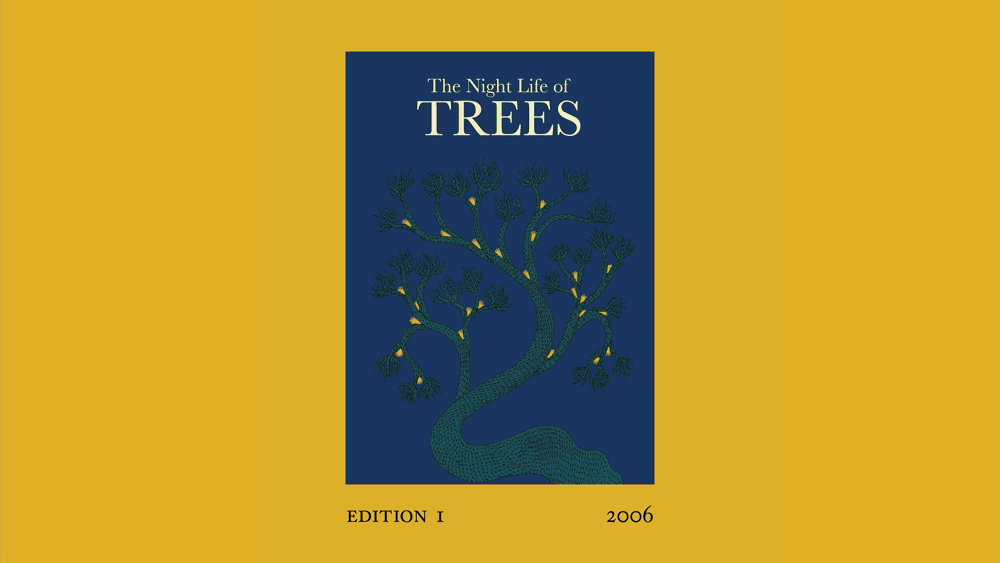
12 Jul Tree Covers: The Night Life of Trees Keeps Growing
by Gita Wolf & Divya Vijayakumar
Our enduring classic The Night Life of Trees is currently in its 15th English-language edition! Along with the 33 foreign language editions of the book, which have been published by our partners in 8 languages, this adds up to a staggering total of 120,864 copies worldwide! Each one of these copies of the book is silkscreen-printed, bound and numbered by hand at our bookmaking workshop in Chennai. The printing process involves layering colours sequentially, with each layer pulled through a silkscreen to create what is called an impression. A single copy of the book is made up of around 83-85 impressions, which are created with painstakingly careful pulls of the screen by hand. So making these books involved at team of about 15 artisans producing at least 10,152,576 impressions over a period of 15 years, and still counting…
The Tree Covers poster we launched to commemorate the 15th Edition of The Night Life of Trees
To celebrate its long-standing legacy, we’ve brought out a poster called Tree Covers, to showcase the many looks of this quintessential book. The Night life of Trees is filled with intricately drawn visions of trees by three of the finest artists from the Gond tribe in Central India. The renowned art critic John Berger called it “a book where the nightingale sings until morning…” and it is this glowing sense of mystery, merging with snippets from everyday life, which give a rootedness to the mythology surrounding trees in the Gond imagination. Its journey began with a simple idea…
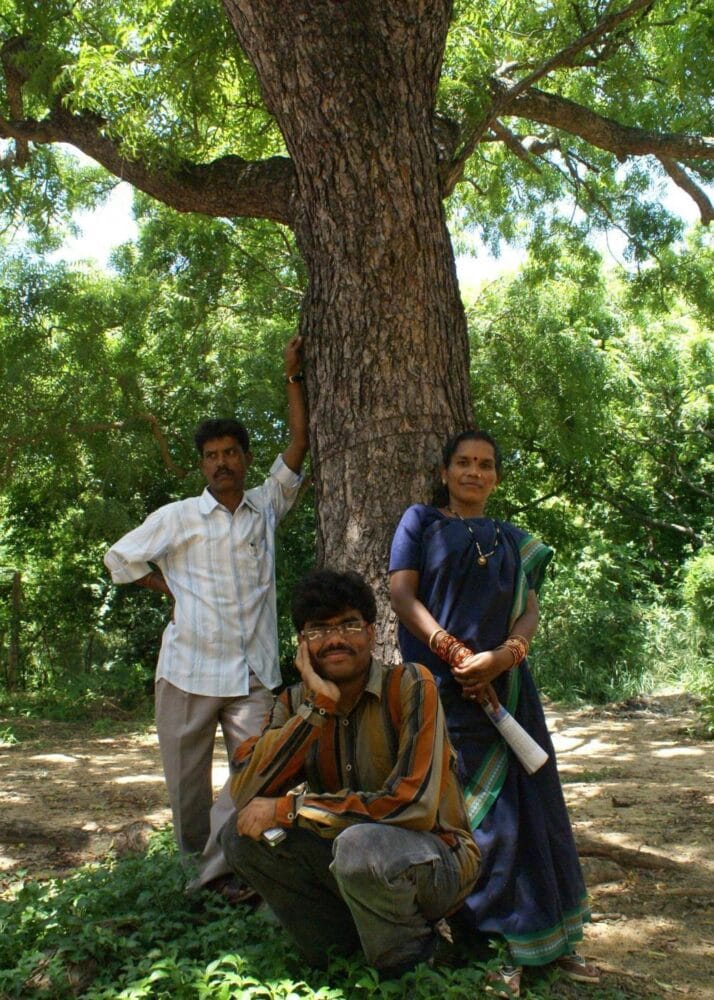
The Night Life of Trees artists Ramsingh Urveti, Bhajju Shyam and Durga Bai (Photo by Alice Fiorelli)
Planting the Seed: How the Book Began
We have been working with Gond artists since 2003. As we got to know their work better, we noticed that trees were central to their art and imagination. A tree helped anchor the narrative, connect natural and human worlds, past and present, art and life… It was as if each of these trees contained multitudes within themselves.
It seemed to us that a book that featured the Gond vision of trees would be an interesting project. We were intrigued by how this could be taken forward, and so we asked Bhajju Shyam, Durga Bai and Ramsingh Urveti to draw portraits of trees, both familiar and fabled, and tell us the traditional stories that went with each of them. While working on the project, they told us about the Gond belief that trees are busy during the day, providing food and shelter to humans and animals. It is only at night, when they are done with their day time duties, that they are free to reveal their true spirit. With this central idea, The Night Life of Trees was born.
Screenprinting The Peacock spread for the 3rd Japanese edition of The Night Life of Trees
Into the Woods: Design and Production
Not entirely sure about the shape this project would take, we requested the artists to create black-and-white line drawings, so that there would be flexibility in how the images could be treated. It was only after the text and images were in place that we knew this was a truly special book that deserved the very finest production: screen printing on handmade paper at our bookmaking workshop in Chennai. After deciding how many traditional Gond colours we wanted to bring in, we added each colour digitally in layers, so that the artwork would be suitable for screen printing.
The book’s designer Rathna Ramanathan took her cue from the title to suggest printing the book on black paper, to evoke the feeling of the forest at night. While this was a brilliant idea, it turned out to be quite a production challenge. It was much harder to source ‘true black’ paper than we thought. Added to this, screen printing colours on a black background is not a simple task. It takes a while for the final shade of the colours to appear on black paper, and our book artisans had to mix colours, test them on the paper, and wait for the sheets to dry before finalising the exact composition of each shade of ink.
The credit for mastering all this goes to C. Arumugam, our production manager, and his team of book artisans. They managed to negotiate every unexpected pitfall and setback to finally create what turned out to be a signature book for Tara. The first edition of The Night Life of Trees was released in 2007, with a print run of 1000 copies. On a side note – you might be interested in reading Rathna’s blog post on sustainable design and production.
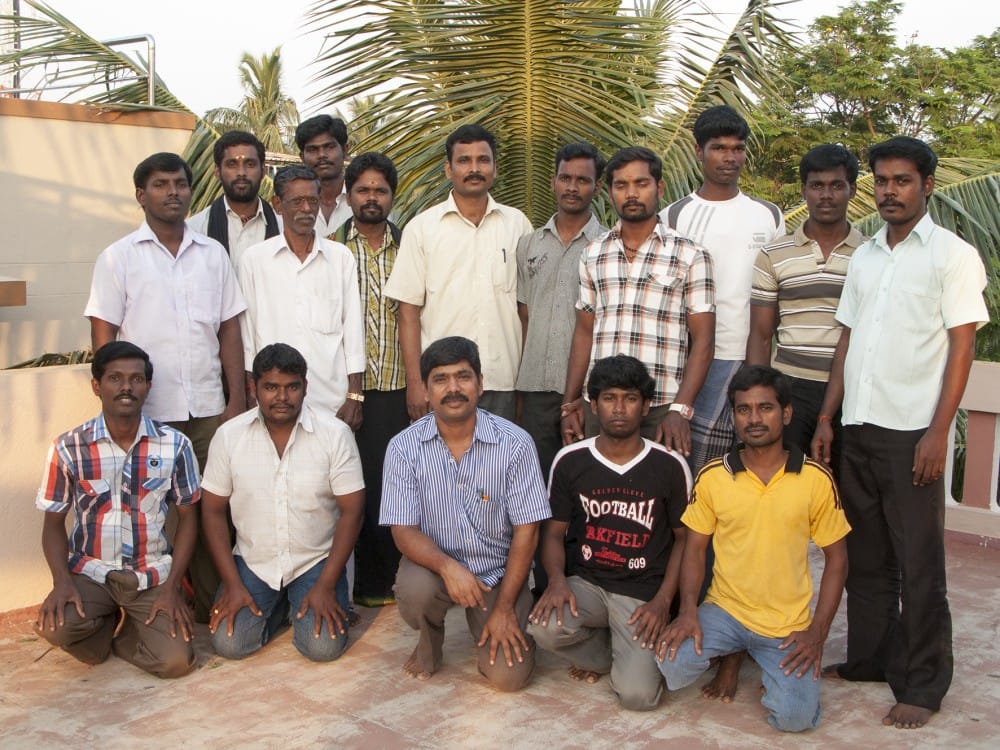
C. Arumugam (bottom-middle) with his team of book artisans at AMM Screens, Chennai
Putting Down Roots: The Early Reception
As is often the case, the life of the book turned out to be different from what we expected. After a painful period of gestation, we were delighted with the result, but to our disappointment, the initial reception from readers was underwhelming — people didn’t know what to make of it. Nothing like it existed in the publishing world: it was genre-defying, bringing folklore and tribal art into the form of what was essentially an artists’ book. But then slowly, its time did come, and we managed to sell through the first lot of 1000 copies. The book then went on to win several awards, including the prestigious Bologna Ragazzi Award in 2008, making it the first Indian book to do so. From then on, the pace of the book’s popularity picked up — and accelerated steadily. The rest, as they say, is history.

We’ve released at least an edition a year, of 3000 copies on average, since the book first came out into the world. The work that goes into producing one edition of The Night Life of Trees, from the printing to the binding, keeps our workshop busy for three months. So far, we’ve printed and bound 37,000 copies of the English language editions… and still counting!
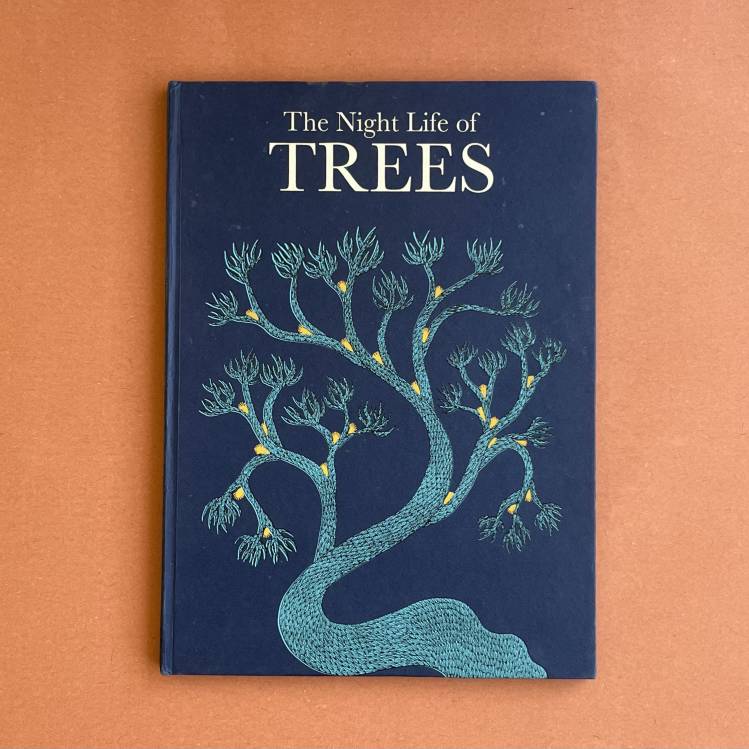
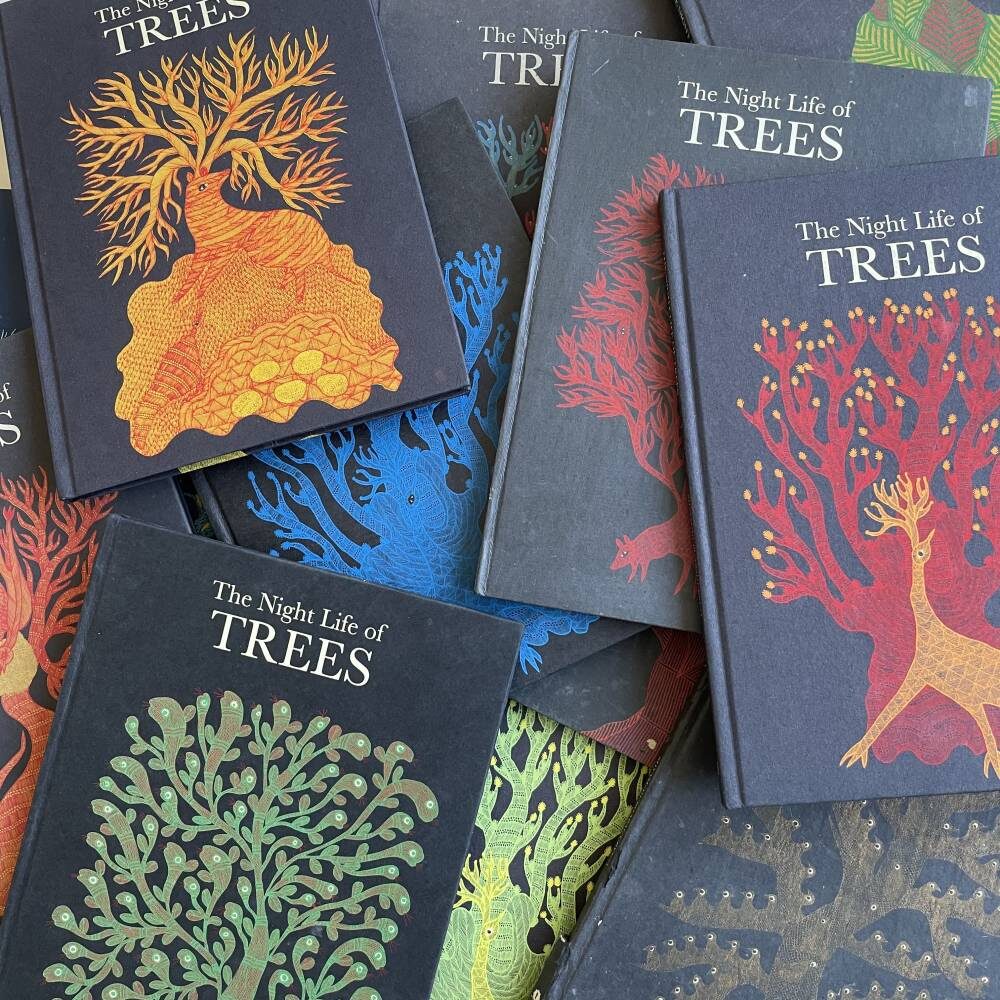
The 1st edition (left) and multiple editions of The Night Life of Trees
New Leaves: The Many Editions
How do we conceive of an edition? In publishing terms, an edition is technically all copies of a book printed from the same setting of type, and a second edition is one where there are changes made to the copy before the book is reprinted. In printmaking, an edition is a number of prints struck from one plate, usually at the same time. This could be a limited edition, with a fixed number of copies of the print produced on the understanding that no further copies will be printed later. Or it can be an open edition, limited only by the number that can be sold or produced before the plate wears out. Most modern artists produce only limited editions, normally signed by the artist in pencil, and numbered as say 20/50, to show the unique number of that impression and the total edition size. Then there are artists’ books, usually made by hand in small batches, which are numbered — and often signed — by the artist.
Our handmade books are artists’ books as well, but rather than create a small number of expensive books, we chose, quite deliberately, to publish a larger number of modestly priced ones. We have built a team of artisans who make these books in larger numbers, and this scale of production makes them affordable to a wider group of readers. The balance we strive to achieve, in terms of scalability, is to keep the artisanal aspect intact, ensure fair wages, and still keep the price point at a level that is rewarding for both the maker and the buyer.
To honour the artisanal labour that goes into making each book, we name and credit all the printers. Taking a cue from printmaking and artist’s books — every print run is limited, and each book is numbered by hand. Each production run is intrinsically special: since the texture and thickness of the handmade paper varies slightly with every batch, the final outcome is always unique. When one particular print run is sold out, we create the next edition. What is special about The Night Life of Trees, is that every edition has featured a brand new cover.

Foreign language editions of The Night Life of Trees
Cross-Pollination: Foreign Language Editions
Like with our own initial edition, the book was a slow starter across the globe. Understandably, publishing houses were initially hesitant about what the publication of a book as unusual as The Night Life of Trees would involve. How feasible was it to produce a handmade book in India and have it shipped? Would the quality be assured? How would readers in their country respond to it? Would their own marketing team be willing to take it on? But as is the case with most publishing projects, the decision to take the risk was a very individual one, and it was the editorial decision makers at our foreign publishing partners who were ready to take the plunge. The book spoke to them in ways they couldn’t resist.
Minoru Tamura, of Tamuro-do, the publisher of the Japanese version of the book, put it this way, “In 2007, I saw The Night Life of Trees at the Bologna Book Fair, and I was deeply impressed by it. Since then, I have been keeping my strong interest in this special book alive for years. I was working at a different publishing house then, and it was not a book they would take on. One day, I got to know that the Japanese rights were still available. So I boldly decided to publish it in Japan on my own, under my own imprint. I was sure that this book was what Japanese people needed, after the Great East Japan Earthquake in 2011. I felt it had some magical power which could heal our hearts and encourage us. Mysterious stories about trees, amazing Gond art, and beautiful bookmaking by hand. This book seemed like a kind of miracle.” He went on to make a huge success of the book in Japan, selling 20,024 copies in 10 editions.
Sonja Matheson, the publisher of Baobab Books in Switzerland, who brought out the German edition, came to the book from another angle, “The Night Life of Trees is truly a gem of a book. It contains all that Baobab Books is looking for – a unique concept, high quality artwork and meaningful text. In our programme we want to focus on marginalised people and make their voices heard – through this book, many people in Europe have heard about the indigenous Gonds for the very first time. This book opened their eyes and their hearts.” The German edition of The Night Life of Trees sold 10,000 copies and went into 5 editions.
Here are all the publishers of The Night Life of Trees around the world, in various languages: Tamura-do in Japanese, Baobab Books in German, Borim Press in Korean, Salani Editore in Italian, WMF Martins Fontes in Portuguese, Kalandraka in Spanish, Actes Sud in French and Grimm Press in Taiwanese Mandarin. In each of these languages, the book has been an unprecedented success and has gone into several editions.
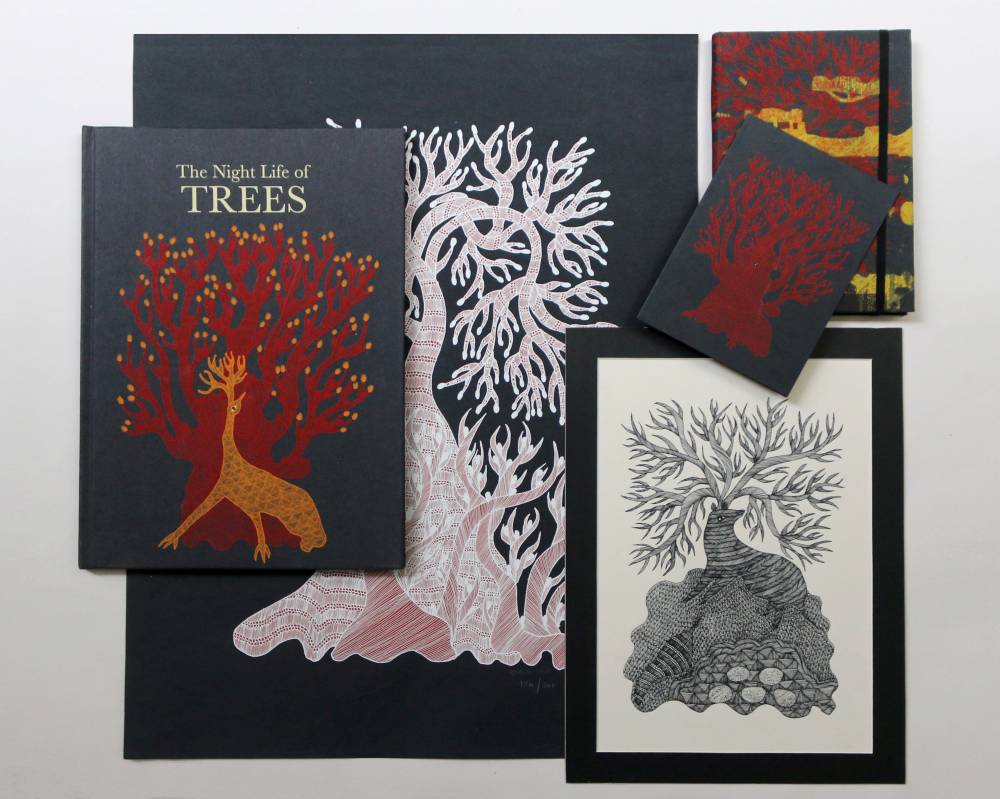
The Night Life of Trees with cards, prints, and a Flukebook upcycled from a misprint
Branching Out: Cards, Art Prints and Exhibitions
Images from The Night Life of Trees continue to offer a rich, almost inexhaustible source of pleasure and wonder. In addition to the book, we’ve come up with a series of affordable art for our readers – cards, art prints, and most recently an affectionate throw back to the initial rendering of the art – a series of black and white original illustrations. Trees from the book have also stepped outside the page to take root in various situations and featured in numerous events. From exhibitions to workshops, The Night Life of Trees has continued to inspire audiences across the world.
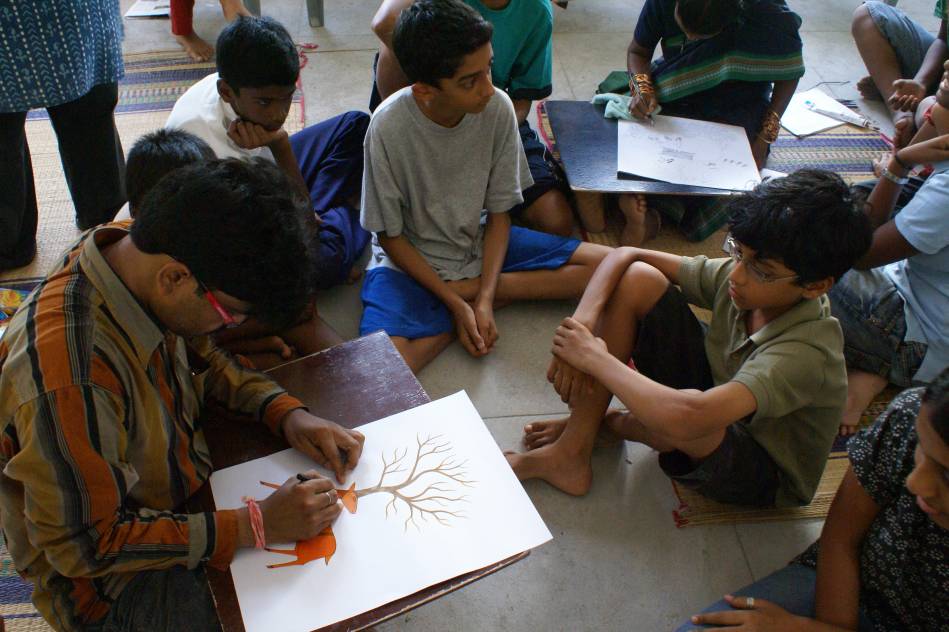

Bhajju Shyam at a children’s workshop in Olcott Memorial School, Chennai in 2007
Exhibition about Tara Books at the Itabashi Art Museum, Tokyo in 2016 (Photo by Kodai Matsuoka)
The Night Life of Trees exhibit at the Heritage Gardens, Singapore (Photo by Gardens by the Bay)
Illustrations from The Night Life of Trees adorn Neil Gaiman’s book covers
An exhibit featuring The Night Life of Trees at the Indian pavilion at the Gardens by the Bay in Singapore, is definitely worth a visit to experience the extended meanings that trees possess, in a magnificent location that celebrates both nature and art. These trees are now part of another literary legacy as well. Discerning readers might spot them in the background of several of Neil Gaiman’s book covers!
Evoking the way in which the roots of trees spread out over vast areas, the affection and regard for The Night Life of Trees keeps growing across the world. We wonder where the book will go next. The poster, we hope, is going up on your wall.
Gita Wolf started Tara Books, as an independent publishing house based in India. An original and creative voice in contemporary Indian publishing, Gita Wolf is known for her interest in exploring and experimenting with the form of the book and has written and over twenty books for children and adults. Several have won major international awards and been translated into multiple languages. Click here to discover Tara Books she has authored.
Divya Vijayakumar is a publishing associate at Tara Books. She lives in Chennai with her family of few humans and many cats. She graduated with a Master of Arts in English Studies from the Department of Humanities and Social Sciences at the Indian Institute of Technology, Madras. She loves a good story and a bad pun.


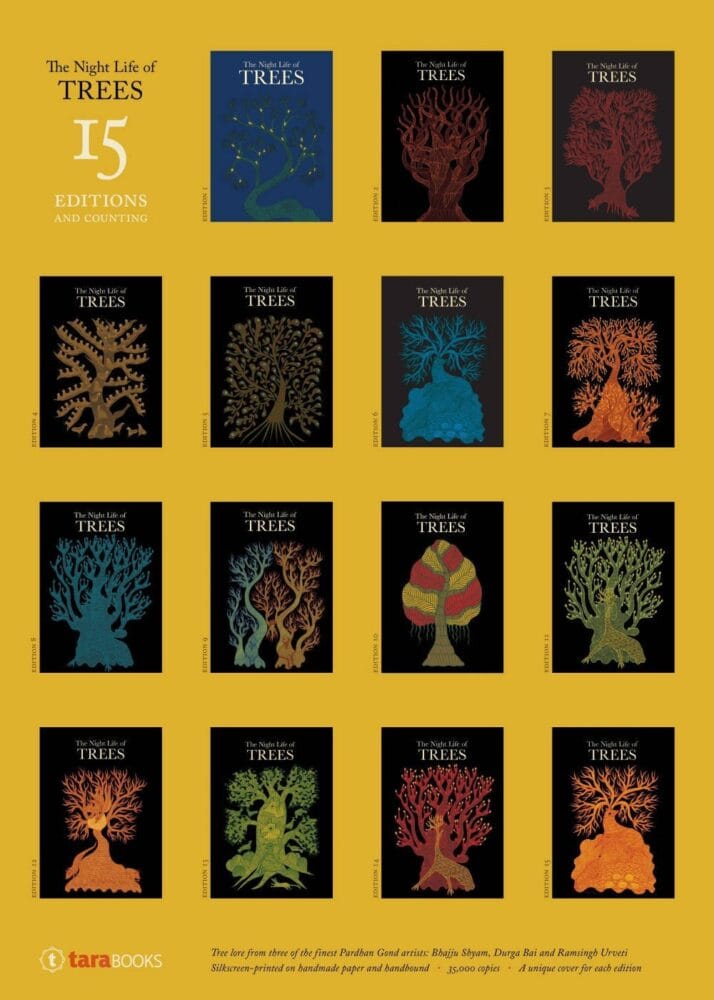




Preeti
Posted at 16:02h, 10 NovemberHi this books looks amazing and I am looking to order a few in different languages for friends and family.
It would be so great if you can post the Titles and ISBN for the various editions as Google translate not so reliable! Thanks a lot.
Incidentally I read about this book & I Saw A Peacock with the Fiery Tale on a website called The Marginalian
https://www.themarginalian.org/2011/09/20/the-night-life-of-trees-tara-books/
And I really wanted to find out more.
Great work. Keep it up